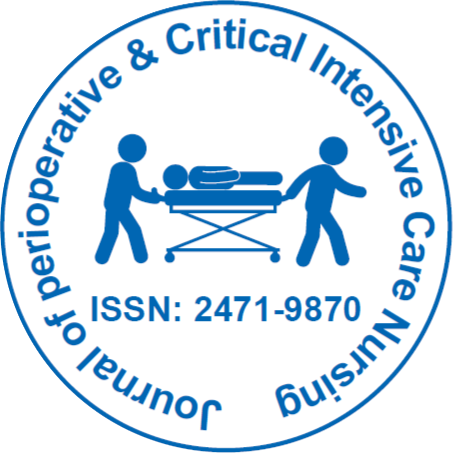
Journal of Perioperative & Critical Intensive Care Nursing
Open Access
ISSN: 2471-9870

ISSN: 2471-9870
Commentary - (2022)Volume 8, Issue 3
Ultrasonography has been used extensively in medicine for decades, but mostly by specialists like radiologists, obstetricians, and cardiologists. Focused point of care ultrasonography is a version of this imaging technique that has recently been performed and interpreted by medical professionals to assist in the immediate evaluation and treatment of their patients. The development of point-of-care ultrasonography has been supported by advancements in ultrasound-related technology, as well as new research and methods showing its value in clinical practice. Before this modality may be used in a variety of disciplines, however, there are still a number of substantial challenges to be overcome, especially with regard to criteria for usage, competency, and training.
Point-of-Care Ultrasound (POCUS) is the term used to describe the capture and interpretation of images by the treating clinician, the end user, at the patient's bedside (POCUS). Without requiring the assistance of an expert to acquire or analyses the photos, it enables real-time, data-driven treatment decisions. This ultrasonography paradigm provides for safe therapies and rapid, straightforward serial reassessments intended to improve diagnosis and monitoring, making it perfect for paediatric critical care. Over the past ten years, paediatric critical care POCUS has made significant advancements. However, like with most significant discoveries, there are many who disagree. POCUS has swiftly expanded, but many issues, particularly those pertaining to training and competency, remain unresolved. Poorly trained users' incorrect interpretations can put patients in grave risk, interrupt work flow, and add to the financial burden. The benefits of using POCUS as an addition to current clinical tools or as an extension of the physical examination, as opposed to using it as a stand-alone tool to preclude or replace other diagnostic modalities, are enormous, and it can provide vital information and guidance in caring for our patients. Since its introduction into clinical practice in the middle of the 20th century, ultrasonography has been a useful technique for noninvasive imaging of many anatomical structures. Its lack of ionizing radiation gives it a substantial advantage over traditional imaging methods. It may also be completed quickly at the patient's bedside (avoiding the need for patient transfers) and with serial imaging, which enables doctors to gauge the effectiveness of therapies prescribed to patients without consulting third parties. Despite being largely utilized by radiologists, ultrasonography has long been a vital technique in many medical and surgical disciplines, including cardiology, gynecology, and obstetrics. The most significant change in paediatric emergency care has been the increasing integration of point-of-care ultrasonography into inpatient paediatric care during the past few decades. Because POCUS is part of emergency care paediatricians' educational programmes and because the American Academy of Pediatrics supports its use in this context, it has solidified as a key technique in paediatric emergency rooms. Its use in this situation has been contrasted with instances when it has been used in hospitals and other medical specializations. And last, POCUS is a crucial method that is frequently used in most PICUs. Numerous studies have shown the most significant therapeutic advantages of POCUS usage by paediatric critical care doctors. Based on the expanding and excellent literature regarding POCUS usage by specialists in paediatric intensive care, it may be said that POCUS is the new stethoscope of critical care physicians. If you have POCUS and an experienced team, you can conduct quick, noninvasive, and repeatable assessments of patients' clinical changes without needing an outside expert. The study supports the widespread use of POCUS in PICUs and its significant therapeutic advantages. In conclusion, for anaesthesiologists and intensivists who treat infants and children, ultrasonography has made great strides in clinical practice. Continuous interest in its application has led to notable advancements in procedure performance in the intra- and perioperative settings, as well as in the diagnosis and treatment of pulmonary and hemodynamic issues, among other things. However, there is still a lot to learn about how the device will work in its expanding use in paediatric settings. It is best to avoid extrapolating conclusions from adult modalities to their use in children. If paediatric anaesthesiologists and intensivists approach the evaluation of point-of-care ultrasonography with the same enthusiasm as surrounds its use at the bedside, these problems will be resolved.
Citation: Taylor T (2022) Ultrasonography in Paediatric Intensive Care Units and Clinicians Level of Training. J Perioper Crit Intensive Care Nurs. 8:204
Received: 22-Nov-2022, Manuscript No. JPCIC-22-21465; Editor assigned: 24-Nov-2022, Pre QC No. JPCIC-22-21465 (PQ); Reviewed: 09-Dec-2022, QC No. JPCIC-22-21465; Revised: 16-Dec-2022, Manuscript No. JPCIC-22-21465 (R); Published: 23-Dec-2022 , DOI: 10.35248/2471-9870.22.8.204
Copyright: © 2022 Taylor T. This is an open-access article distributed under the terms of the Creative Commons Attribution License, which permits unrestricted use, distribution, and reproduction in any medium, provided the original author and source are credited.